Institute to keep monitoring key locations, viral mutations


China will change the way it monitors and publishes COVID-19 data as the management of the virus will be downgraded to Class B from Jan 8, which means it is considered less severe.
Yin Wenwu, a senior doctor at the Chinese Center for Disease Control and Prevention, said at a news conference on Tuesday that the country will only make public the number of confirmed cases, severe cases and deaths. The tally will no longer differentiate domestic and imported cases. Information about close contacts will no longer be published.
Local governments should report the daily number of positive nucleic acid tests, according to a notice issued by the State Council on Monday.
In addition, medical institutes should monitor the virus and report the gene sequence of variants to the center.
Samples from key groups should be analyzed, including those of inbound arrivals and workers at key locations to keep abreast of mutations in strains.
The central government will select qualified cities to collect sewage samples from treatment plants for nucleic acid testing to understand the rate of positive cases and the viral load changes in environmental samples.
"The monitoring of mutations will be boosted and the results will be published on the website of the Chinese Center for Disease Control and Prevention, and monitoring will focus on key groups," Yin said.
The central government urged local governments to protect vulnerable groups through regular health monitoring of the elderly and primary and middle school students.
All local governments should gather experts and teams from universities and scientific research institutes to improve the accuracy of monitoring and early warning systems.
Information should be analyzed on a daily basis, to study the scale, intensity and scope of the epidemic and predict trends and the likely duration of outbreaks.
- Prospering Xizang sees surge in overseas visitors
- Couple who lied about panda abuse sentenced
- Senior obstetrician buried in Henan after sudden death
- China sends 11th peacekeeping police unit to South Sudan
- Influencers from around globe begin discovery tour of Ningxia
- Guidelines issued for sale of anti-malaria medication in Guangdong province





































